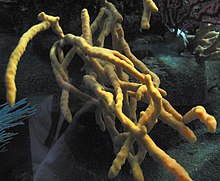
Sponges, the members of the phylum Porifera, are a basal animal clade as a sister of the Diploblasts. They are multicellular organisms that have bodies full of pores and channels allowing water to circulate through them, consisting of jelly-like mesohyl sandwiched between two thin layers of cells.

Demosponges (Demospongiae) are the most diverse class in the phylum Porifera. They include 76.2% of all species of sponges with nearly 8,800 species worldwide. They are sponges with a soft body that covers a hard, often massive skeleton made of calcium carbonate, either aragonite or calcite. They are predominantly leuconoid in structure. Their "skeletons" are made of spicules consisting of fibers of the protein spongin, the mineral silica, or both. Where spicules of silica are present, they have a different shape from those in the otherwise similar glass sponges. Some species, in particular from the Antarctic, obtain the silica for spicule building from the ingestion of siliceous diatoms.

The Canal de São Vicente is a strait of the Atlantic Ocean separating the islands of Santo Antão and São Vicente, Cape Verde. At its narrowest point, it is 11 km (7 mi) wide. The ferry route between the ports of Porto Novo on Santo Antão and Mindelo on São Vicente crosses the canal. The channel begins in São Vicente's northwesternmost cape near Monte Cara up to the headland Ponta de João d'Évora in the northeast.
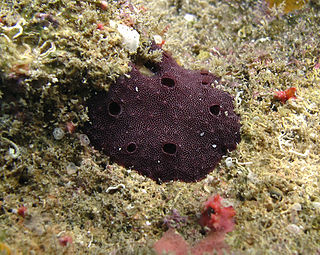
Dendroceratida is an order of sponges of the class Demospongiae. They are typically found in shallow coastal and tidal areas of most coasts around the world. They are generally characterized by concentric layers of fibers containing spongin, and by large flagellated chambers that open directly into the exhalant canals. Along with the Dictyoceratida, it is one of the two orders of demosponges that make up the keratose or "horny" sponges, in which a mineral skeleton is minimal or absent and a skeleton of organic spongin-containing fibers is present instead.
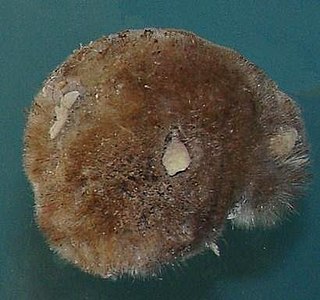
Polymastiidae is a family of demosponges found in oceans throughout the world. It is the only family in the monotypic order Polymastiida. A useful diagnostic characteristic of members of this family is the presence of numerous surface papillae although this feature is shown by some other sponges.
Acanthopolymastia is a small genus of demosponges belonging to the family Polymastiidae. It has three describe species. These small, bristly, cushion-shaped sponges are only known from deep-sea sites in the southern oceans.

Spicules are structural elements found in most sponges. Sponge spicules are made of calcium carbonate or silica. Large spicules visible to the naked eye are referred to as megascleres, while smaller, microscopic ones are termed microscleres. The meshing of many spicules serves as the sponge's skeleton and thus it provides structural support and potentially defense against predators. The composition, size, and shape of spicules are major characters in sponge systematics and taxonomy.
The brain sponge is a species of marine demosponge in the family Isodictyidae. This sponge is known from the west coast of South Africa to Port Elizabeth. It is endemic to this region.

Myxilla incrustans is a species of demosponge. It is an encrusting species and is usually yellow.
Parenchymella is a type of larva of a demosponge composed of an envelope of flagellated cells surrounding an internal mass of cells. Demospongiae develops directly into solid stereoblastula. It then develops flagellae to form parenchymella.
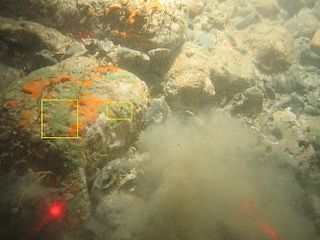
Hymedesmiidae is a family of demosponges in the order Poecilosclerida.

Bubarida is an order of demosponges in the subclass Heteroscleromorpha.

Clionaida is an order of demosponges in the subclass Heteroscleromorpha.

Scopalinidae is an family of demosponges in the subclass Heteroscleromorpha. It is the only family in the monotypic order Scopalinida.
Biemnida is an order of demosponges in the subclass Heteroscleromorpha.

Geodia megastrella is a species of sponge in the family Geodiidae. It is a type of demosponge found in the deep temperate waters of the North Atlantic Ocean. It has characteristic stellar-shaped large spicules coined 'megastrellum', hence its name. The species was first described by Henry John Carter in 1876, after dredging it up aboard H.M.S. 'Porcupine', near the Cape St. Vincent in Portugal.
Geodia atlantica is a species of sponge in the family Geodiidae. It is found in the waters of the North Atlantic Ocean.
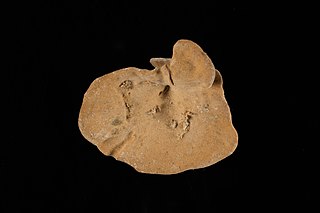
Cymbastela lamellata is a species of marine sponge in the family Axinellidae.
Dragmacidon australe is a species of sponge in the family, Axinellidae.
Acanthella dendyi is a marine sessile filter-feeder sponge in the family Dictyonellidae, first described by Patricia Bergquist in 1970 as Phakellia dendyi
